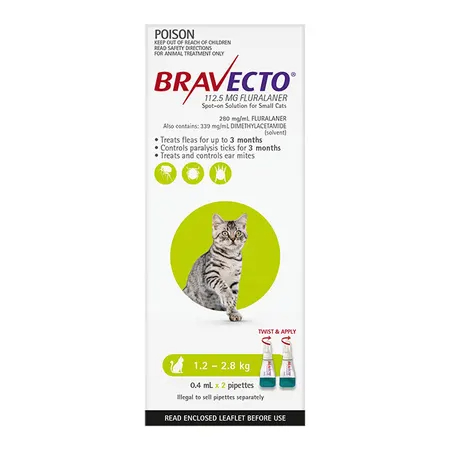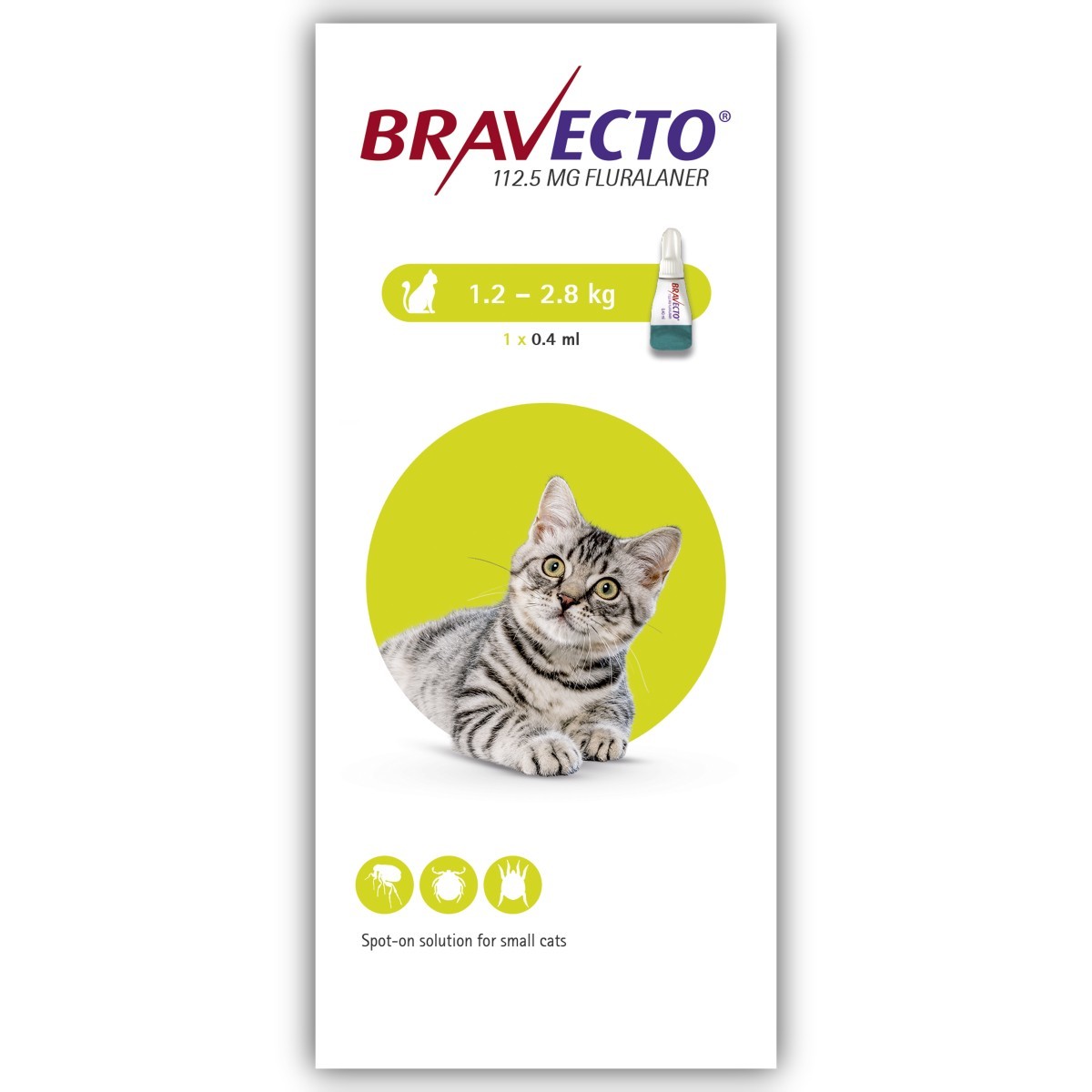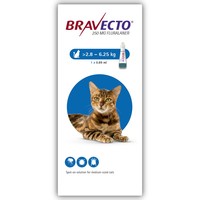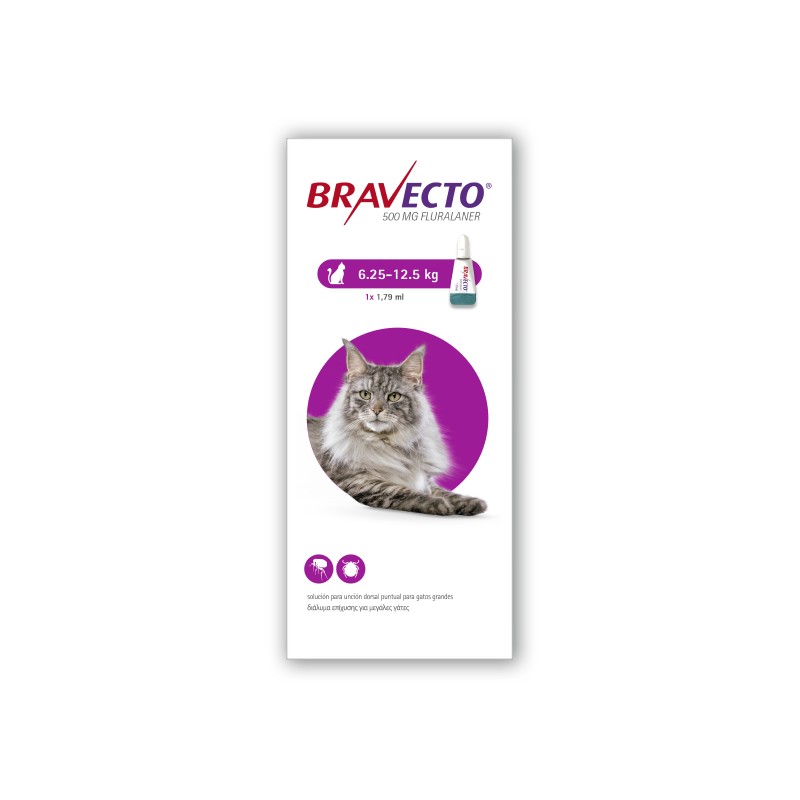Bravecto® Plus spot-on solution for cats Bravecto Plus is the first spot-on solution for cats to protect against fleas and ticks for 12 weeks and treats ear mites and a broad spectrum of worms1. It contains fluralaner and moxidectin For spot-on use. Bravecto Plus spot-on solution is available in three pipette sizes. The following table defines the size of pipette to be used according to the body weight of the cat (corresponding to a dose of 40 94 mg fluralaner/kg body weight and 2 4.7 mg moxidectin/kg body weight): Weight of cat (kg) Pipette size to be used 1.2 – 2.8 Bravecto Plus 112.5 mg + 5.6 mg spot-on solution for small cats >2.8 – 6.25 Bravecto Plus 250 mg + 12.5 mg spot-on solution for medium-sized cats >6.25 – 12.5 Bravecto Plus 500 mg + 25 mg spot-on solution for large cats Method of administration Step 1: Immediately before use, open the sachet and remove the pipette. Put on gloves. The pipette should be held by the base or by the upper rigid portion below the cap in an upright position (tip up) for opening it. The twist-and-use cap should be rotated clockwise or counterclockwise one full turn. The cap will stay on the pipette; it is not possible to remove it. The pipette is open and ready for application when the breaking of the seal is felt. Step 2: The cat should be standing or lying with its back horizontal for easy application. Place the pipette tip on the base of the skull of the cat. Step 3: Squeeze the pipette gently and apply the entire contents directly to the cat’s skin. The product should be applied on cats up to 6.25 kg body weight in one spot at the base of the skull and in two spots at the base of the skull on cats greater than 6.25 kg bodyweight. Species: Cats Therapeutic indication: Pharmaceuticals: Ectoparasiticides: For cats Active ingredient: Fluralaner, Moxidectin Product:Bravecto® Plus spot-on solution for cats Product index: Bravecto Plus spot-on solution for cats Qualitative and quantitative composition Active substance: Each ml of solution contains 280 mg fluralaner and 14 mg moxidectin. Each pipette delivers: BRAVECTO PLUS spot-on solution Pipette content (ml) Fluralaner (mg) Moxidectin (mg) for small cats 1.2 - 2.8 kg 0.4 112.5 5.6 for medium-sized cats >2.8 - 6.25 kg 0.89 250 12.5 for large cats >6.25 - 12.5 kg 1.79 500 25 Excipient(s): Butylhydroxytoluene 1.07 mg/ml For the full list of excipients, see section “Pharmaceutical particulars”. Pharmaceutical form Spot-on solution. Clear colourless to yellow solution. Clinical particulars Target Species Cats. Indications for use For cats with, or at risk from, mixed parasitic infestations by ticks or fleas and ear mites, gastrointestinal nematodes or heartworm. The veterinary medicinal product is exclusively indicated when use against ticks or fleas and one or more of the other target parasites is indicated at the same time. For the treatment of tick and flea infestations in cats providing immediate and persistent flea (Ctenocephalides felis) and tick (Ixodes ricinus) killing activity for 12 weeks. Fleas and ticks must attach to the host and commence feeding in order to be exposed to the active substance. The product can be used as part of a treatment strategy for flea allergy dermatitis (FAD). For the treatment of infestations with ear mites (Otodectes cynotis). For the treatment of infections with intestinal roundworm (4th stage larvae, immature adults and adults of Toxocara cati) and hookworm (4th stage larvae, immature adults and adults of Ancylostoma tubaeforme). When administered repeatedly at a 12-week interval, the product continuously prevents heartworm disease caused by Dirofilaria immitis (see details in section “Amounts to be administered and administration route”). Contraindications Do not use in case of hypersensitivity to the active substance or to any of the excipients. Special warnings for each target species Ticks and fleas need to start feeding on the host to become exposed to fluralaner; therefore the risk of the transmission of parasite borne diseases cannot be excluded. Cats in areas endemic for heartworm (or those which have travelled to endemic areas) may be infected with adult heartworms. No therapeutic effect against adult Dirofilaria immitis has been established. It is therefore recommended, in accordance with good veterinary practice, that animals of 6 months of age or older and living in areas where a vector exists, should be tested for existing adult heartworm infections before application of the veterinary medicinal product for the prevention of heartworm disease. For the prevention of heartworm disease in cats that are only temporarily in endemic areas, the product should be applied before the first expected exposure to mosquitoes and should be continued at 12-week intervals until return to a non-endemic area. The period between treatment and return from the endemic areas should not exceed 60 days. For the treatment of infections with ear mites (Otodectes cynotis) or the gastrointestinal nematodes T. catiand A. tubaeforme, the need for, and the frequency of, re-treatment as well as the choice of the treatment (monosubstance or combination product) should be evaluated by the prescribing veterinarian. Parasite resistance to any particular class of anthelmintic may develop following frequent, repeated use of an anthelmintic of that class under specific circumstances. The use of this veterinary medicinal product should be based on the assessment of each individual case and on local epidemiological information about the current susceptibility of the target species in order to limit the possibility of a future selection for resistance. Parasite control is recommended throughout the period of potential infestation risk. Avoid frequent swimming or shampooing the animal because the maintenance of effectiveness of the product in these cases has not been tested. Special precautions for use Care should be taken to avoid contact with the eyes of the animal. Do not use directly on skin lesions. In the absence of available data, treatment of kittens less than 9 weeks of age and cats less than 1.2 kg bodyweight is not recommended. Treatment of male breeding animals is not recommended. This product is for topical use and should not be administered orally. Oral uptake of the product at the maximum recommended dose of 93 mg fluralaner + 4.65 mg moxidectin/kg body weight induced some self-limiting salivation or single incidences of vomiting immediately after administration. It is important to apply the dose as indicated to prevent the animal from licking and ingesting the product (see details in the “Adverse Reactions” and “Amounts to be administered and administration route” sections). Do not allow recently treated animals to groom each other. Do not allow treated animals to come into contact with untreated animals until the application site is dry. Operator warnings Contact with the product should be avoided and disposable protective gloves obtained with this product at the point of sale must be worn when handling the product for the following reasons: •Hypersensitivity reactions have been reported in a small number of people, which can potentially be serious. •Persons with a hypersensitivity to fluralaner or to any of the excipients should avoid any exposure to the product. •The product binds to the skin and may also bind to surfaces after spillage of the product. Skin rashes, tingling or numbness have been reported in a small number of individuals after skin contact. If skin contact does occur, wash the affected area immediately with soap and water. In some cases, soap and water are not sufficient to remove the product spilt on the fingers. Contact with the product may also occur when handling the treated animal. Make sure that your animal’s application site is no longer noticeable before resuming contact with the site of application. This includes cuddling the animal and sharing a bed with the animal. It takes up to 48 hours for the application site to become dry but it will be noticeable for longer. If skin reactions occur, consult a physician and show them the product packaging. People with a sensitive skin or known allergy in general e.g. to other veterinary medicinal products of this type should handle the veterinary medicinal product as well as treated animals with caution. This product can cause eye irritation. In case of contact with the eyes, immediately rinse thoroughly with water. This product is harmful after ingestion. Keep the product in the original packaging until use, in order to prevent children from getting direct access to the product. A used pipette should immediately be disposed of. In case of accidental ingestion, seek medical advice and show the package leaflet or the label to the physician. The product is highly flammable. Keep away from heat, sparks, open flame or other sources of ignition. In case of spillage onto, for example table or floor surfaces, remove excess product using paper tissue and clean the area with detergent. Adverse Reactions Mild and transient skin reactions at the application site (alopecia, flaking skin, redness and pruritus) were commonly observed in clinical trials. Dyspnoea after licking the application site, hypersalivation, emesis, haematemesis, diarrhoea, lethargy, pyrexia, tachypnoea and mydriasis were uncommonly observed in clinical trials shortly after administration. Anorexia as well as neurological manifestations such as tremors and ataxia have been reported very rarely after the use of this product based on post marketing safety experience. The frequency of adverse reactions is defined using the following convention: − very common (more than 1 in 10 animals treated displaying adverse reaction(s)) − common (more than 1 but less than 10 animals in 100 animals treated) − uncommon (more than 1 but less than 10 animals in 1,000 animals treated ) − rare (more than 1 but less than 10 animals in 10,000 animals treated) − very rare (less than 1 animal in 10,000 animals treated, including isolated reports) Use during pregnancy or lactation The safety of the veterinary medicinal product has not been established in pregnant or lactating animals and therefore use in such animals is not recommended. Interactions Macrocyclic lactones including moxidectin have been shown to be substrates for p-glycoprotein. Therefore, during treatment with Bravecto Plus, other products that can inhibit p-glycoprotein (e.g. cyclosporine, ketoconazole, spinosad, verapamil) should only be used concomitantly according to the benefit-risk assessment of the responsible veterinarian. Amounts to be administered and administration route Within each weight band, the content of one whole pipette should be used. For cats more than 12.5 kg, use a combination of two pipettes that most closely matches the body weight. Treatment For the concurrent treatment of infections with ear mites (Otodectes cynotis), a single dose of the product should be applied. Seek further veterinary examination (i.e. otoscopy) 28 days after treatment to determine whether there is re-infestation requiring additional treatment. The choice of the additional treatment (monosubstance or combination product) should be determined by the prescribing veterinarian. For the concurrent treatment of infections with the gastrointestinal nematodes T. cati and A. tubaeforme, a single dose of the product should be applied. The need for and frequency of re-treatment should be in accordance with the advice of the prescribing veterinarian and take into account the local epidemiological situation. Where necessary, cats can be re-treated at 12-week intervals. Cats in areas endemic for heartworm, or cats which have travelled to endemic areas, may be infected with adult heartworms. Therefore prior to application of Bravecto Plus for the concurrent prevention of infection with adult D. immitis, the advice provided in section 4.4 should be considered. At the time of treatment, the product is effective against D. immitis larvae (L3 and L4), which have infected the cat in the previous 30 days. The product is effective against incoming D. immitis larvae (L3) for 60 days after treatment. Therefore, for continuous prevention of heartworm disease cats need to be retreated at 12-week intervals. Overdose No adverse reactions were observed following topical administration to kittens aged 9-13 weeks and weighing 0.9-1.9 kg treated with overdoses of up to 5 times the maximum recommended dose (93 mg fluralaner + 4.65 mg moxidectin, 279 mg fluralaner + 13.95 mg moxidectin and 465 mg fluralaner + 23.25 mg moxidectin/kg body weight) on three occasions at shorter intervals than recommended (8-week intervals). Withdrawal periods Not applicable.

